Shiliuyun/Xinjiang Daily (Reporter: Yinlu) news: Recently, a snow leopard visited the Jiangjunshan Ski Resort in Altay City at night, which has aroused attention. In fact, besides snow leopards, many other wild animals such as wolverines, red foxes, ibexes and moose are also active in the mountains in Altay Prefecture in winter. In recent years, relevant conservation departments have set up many infrared cameras to monitor changes in biological populations, so the number of wildlife captured on camera is increasing. On January 5, 2023, the reporter came to the Wildlife Protection and Monitoring Station of Altay Prefecture for an interview, taking you to learn more about these amazing animals that broke into the camera.
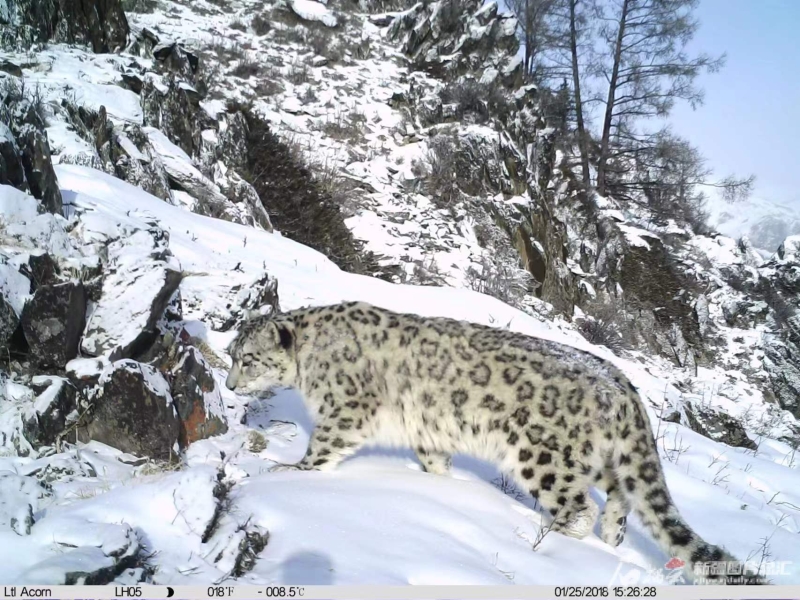
A snow leopard. (Photo provided by Altai Mountain Liangheyuan Nature Reserve, Xinjiang Uygur Autonomous Region)
Snow Leopards: sports masters in the snowy mountains
Snow leopards live in high altitude snow mountains where there are vast stretches of bare rocks and frigid desert areas, and animals they love to eat such as ibexes, argalis, highland rabbits and dry otters also live here.
Snow leopards generally live in rocky crevices and caves in high mountains, and have certain planned route when they go out. In order to hunt for food, they will go far away, and in many cases, they can walk more than 20 kilometers a day.
Snow leopards are absolute sports masters, they are agile and nimble, and can jump up and down cliffs to heights between 4 to 6 meters.
In the past five years, 18 snow leopards were recorded in the Altay Prefecture.

A wolverine. (Photo taken by Li Jianqiang and provided by the Wildlife Protection and Monitoring Station of Altay Prefecture, Xinjiang Uygur Autonomous Region)
Wolverines: ‘Foodies’ who love doing a sneak attack
Wolverines are named for their cub-like appearance and long tails similar to those of martens.
They are fierce and agile, with strong climbing, swimming and jumping abilities. They generally live in cold-temperate forests and grasslands, and their fur color changes with the seasons, presenting protective color.
As “foodies”, they are particular about the balanced portion of meat and vegetables in their diet, and they pay attention to mushroom and nut intake. When hunting, they prefer sneak attack, leaping from trees, controlling the prey with sharp claws and body, so small animals are difficult to escape.
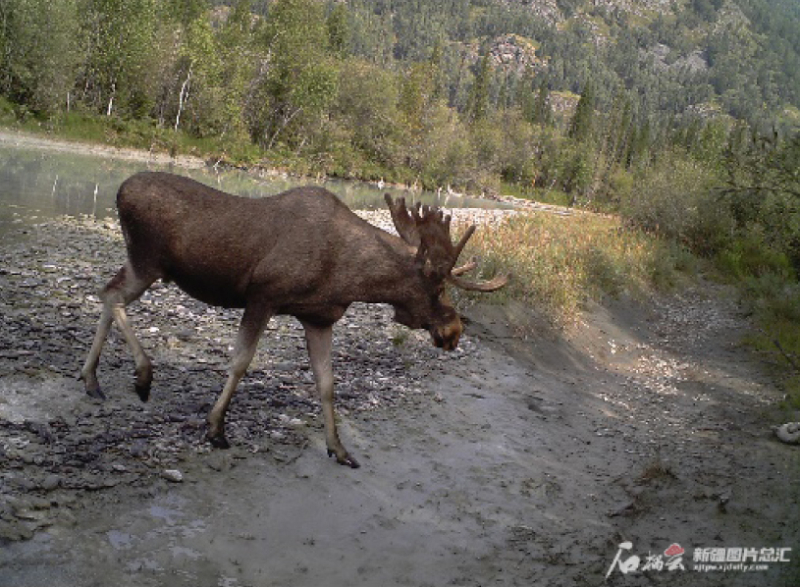
Photo shows the screenshot of a moose from an infrared camera monitoring bird and animal species in Kanas Valley, Altai Mountains, Xinjiang. (Photo provided by the Wildlife Protection and Monitoring Station of Altay Prefecture, Xinjiang Uygur Autonomous Region)
Moose: the largest deer in the world
Moose are the largest deer in the world, with a body length between 2 meters to 2.5 meters. They live mainly in cold-temperate coniferous forests at altitudes below 2,500 meters and have strong cold tolerance. To find food, they will complete migrations of up to 300 kilometers in groups.
The lamellar antlers of the male moose are unique among the deer species and resemble giant cacti, and they are also their weapons.
Moose is the best swimmer among its species. It has developed the ability to swim more than ten kilometers at a time in order to meet the needs of long-distance trekking.
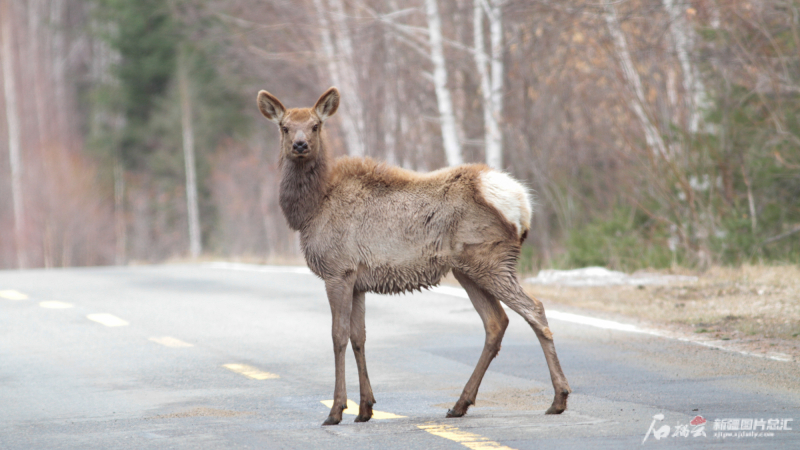
A Red deer. (Photo taken by Ding Peng and provided by the Wildlife Protection and Monitoring Station of Altay Prefecture, Xinjiang Uygur Autonomous Region)
Red deer: a large herd family
Red deer and their large herd families live in forests and grasslands at altitudes below 3,000 meters. They migrate as the season changes, seeking places where water is plentiful, the environment is secluded, and plants are abundant to reside in.
They have plenty of predators, so they run fast and have a keen sense of hearing and smell. In addition to running when in danger, they can also fight with small predators.
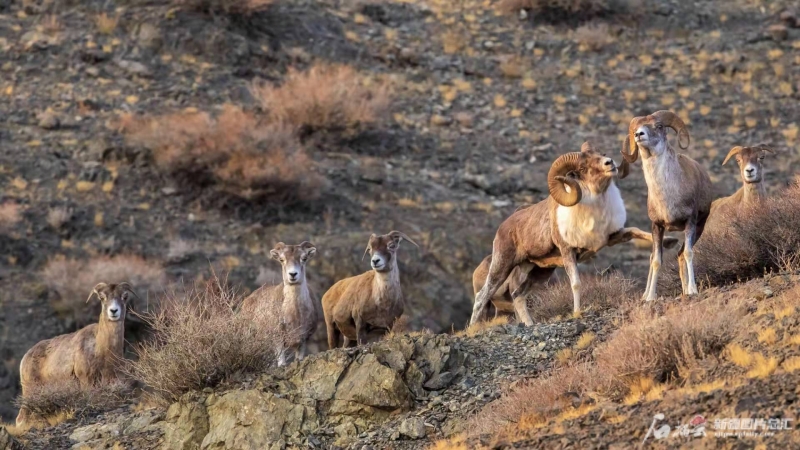
Argalis. (Photo taken by Li Jianqiang and provided by the Wildlife Protection and Monitoring Station of Altay Prefecture, Xinjiang Uygur Autonomous Region)
Argalis: the main characters on the petroglyphs
Argalis often appear on petroglyphs left by ancient people, and the exaggeratedly curved horns of them are obvious markers.
They mostly live in the alpine bare rocks, deserts and grasslands that are 1,500 to 5,500 meters above the sea level, and are used to seasonal vertical migration.
Besides, they are herd animals. When feeding and resting in groups, there is always an adult argali on sentry duty, ready to give warning signals.
And they live in places frequented by snow leopards, wolves and so on.
In recent years, monitoring has revealed an increase in the population of argalis in Altay Prefecture.
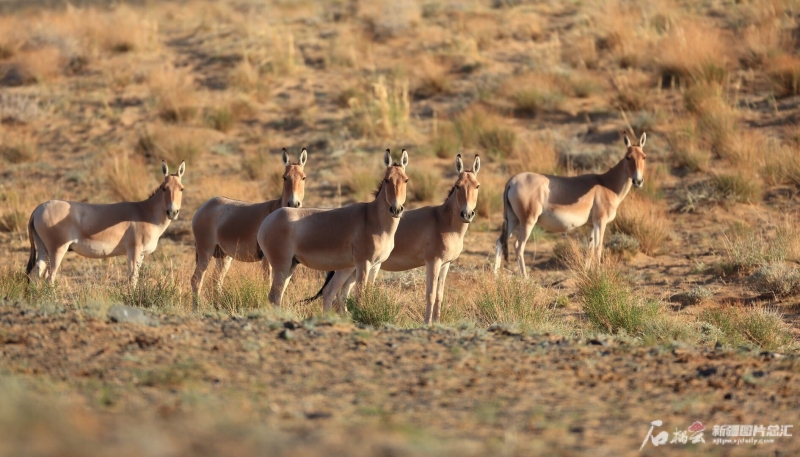
Equus hemionuses. (Photo taken by Renzhe and provided by the Wildlife Protection and Monitoring Station of Altay Prefecture, Xinjiang Uygur Autonomous Region)
Equus hemionuses: knowing how to dig pits to store water
Equus hemionuses are animals under first-class state protection, living in subfrigid desert and semi-desert areas. They migrate as the season changes to ensure that the population has sufficient food and water.
Running is their best escape skills when facing danger, and their speed can reach 45 kilometers per hour.
The long-term natural living environment has developed their abilities to withstand cold, hunger and thirst. And another skill is to dig a shallow pit in a place with high groundwater table to store water, of which during times of drought, other animals often come to take advantage.

A rock ptarmigan. (Photo taken by Ding Peng and provided by the Wildlife Protection and Monitoring Station of Altay Prefecture, Xinjiang Uygur Autonomous Region)
Rock ptarmigan: different colors in winter and summer
Rock ptarmigans are hardy birds that can survive in cold forests, meadows, and alpine coniferous forests, and they love to eat buds, branches, leaves, flowers, fruits, and seeds of plants.
Presently, they have only been found in the Altai Mountain in Xinjiang, China. Although they live in the cold zone, they also seek relatively warmer places to inhabit in winter.
Their feathers change with the seasons, which plays a protective role. They are mostly dark brown with white underparts in summer, and mostly white all over in winter with black on the tail.

An Altai snow chicken. (Photo taken by Renzhe and provided by the Wildlife Protection and Monitoring Station of Altay Prefecture, Xinjiang Uygur Autonomous Region)
Altai snow chickens: the master climbers
Altai snow chickens generally migrate to alpine forests and grasslands at an altitude of about 2,000 meters in winter, and are highly capable of running up and climbing hills, which is also a way to escape from danger.
They are few in number in China and are found only in the mountainous areas in the Altai Mountains and the Beitashan Mountains in Mulei Kazakh Autonomous County, and are animals under second-class state protection.
(A written permission shall be obtained for reprinting, excerpting, copying and mirroring of the contents published on this website. Unauthorized aforementioned act shall be deemed an infringement, of which the actor shall be held accountable under the law.)









